Getting to experience any permutation of art in person is something one cannot miss out on. Getting to write about it is an even bigger pleasure, so when The Workprint was invited to visit the works of one of the most elusive artists of all time, Banksy, we couldn’t pass up the opportunity.
The “Banksy: Building Castles in the Sky” exhibit taking up residence through early September in the former International Center of Photography Museum at 250 Bowery in New York City is the first of its kind, weaving academia with key pieces in the Bristol-born artist’s oeuvre, mapping out a tangible progression before your very eyes.
Sometimes, one can sum up a novel’s worth of feelings within a single image, but you can have two people look at the same piece and be in two vastly different worlds.
What follows is the critique of both Robert Kijowski and Eileen Ramos from the Banksy exhibition exemplifying that sometimes it truly does pay off to have your head in the clouds.
Robert J. Kijowski’s Impresssions
Revolution starts with but three base ingredients: a message, a target, and a vision.
The avenues of such a recipe may be finessed to potency and dispatched, are something of equal mystery and beauty.
In the past, propaganda had a bittersweet-tasting message for the target audience with a vision for a noxious ending for the intended target, whether through literature, art, or music.
It is in this that the ever-elusive street artist Banksy proves that recipes can be elevated.
In their academic and comprehensive collection of over 100 works of this world-renowned Rat-ical, METAMORFOSI NY presents BANKSY, building castles in the sky, provides a fully immersive timeline of how sometimes, to be beyond a revolution, to have both prince and pauper, left and right, pretty and ugly come together, it takes a bit of cunning.
However, he took but two ingredients: a sharp blade with a sharper mind.
While the start of the journey brings you to Banksy’s literal “Welcome (Gross Domestic Product)” mat, constructed of stitched life vests from Greek refugee camps brings the message “home”, we truly start on one of his earliest pieces, which is a DJ in the clouds entitled “Cloud DJ”. Notice the saw blade. This will be a throughline in his earliest works, as he wants to chop his existence of a provincial town in half and stir it all up.
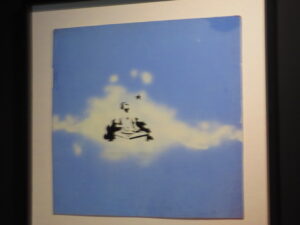
I mean, it’s no surprise that ya boy had been influenced by hip-hop from an early age. The guy started out as a straight graffiti artist in the hardest part of Bristol. Having mastered “getting up”, this was his first foray into putting in some stencil influence. The saw blade was, as I imagined one of his first wordplays in images, with both the saw being a cutting through his monotony of Bristol and how a DJ ‘cuts’ records in your classic 80’s Wild Style era.
Fast forward a few years, when Santa’s Ghetto was the first of its kind: pop art with a message. Therein bloomed the Happy Choppers, which had both a cohesive and conflicting message. We are not the enemy for loving, though in wartime, those that want peace are seen as enemies by the ones that take up arms. These are the ones that have an end goal in mind. Peace. This is potent to show the enemy having emotions instead of simply being a black and white purview to an endgame. We’re all human and nothing of that should be discounted.
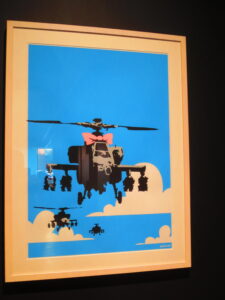
Going back to a very provincial institution and putting his own spin on injecting the stiff upper lips of the polity with a serum of the vox populi, Banksy was welcomed to the Bristol Museum… or rather as a challenge to them.
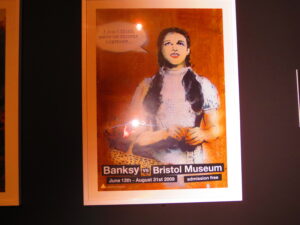
In a way, it was low art vs. high art. It wasn’t so much a battle, because we already knew who won when his peace cozied up to theirs.
Everybody won!
The old guard was long dead, BUT it complemented the new guard, giving it new life.
Art never dies. It just repurposes.
This couldn’t be more evident than when Banksy created his Di-Tenners, essentially making Princess Diana the face of what was once a simple ten-pound note into visual wordplay, as you can pronounce it “Di” or “Dee” as in defaced.
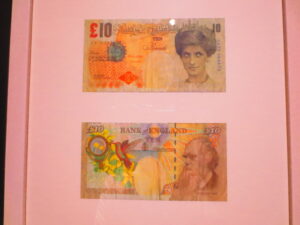
As we moved along the path, Rats were met with us as we were met with rats.
Blek le Rat was a huge influence on Banksy, as the French stencil artist not only used the rodents as a proxy for those that come from the underground but also as a symbol for those that are seen but barely paid attention to.
They are kicked to the gutter and simply overlooked.
Rats are a hearty and sturdy bunch. While the upper crust cares less about the poorer, armies form.
The less attention they are given, the more attention is pressed, and that’s where strength takes place.
Do you know what a group of rats is called?
It’s called a “mischief.” Some niblets to chew on.
It is within this nibbling that we get to Banksy continuing on his mission.
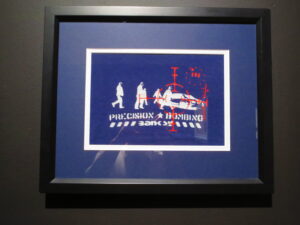
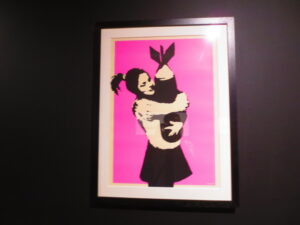
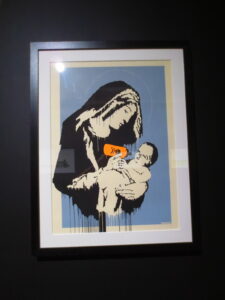
Take, for instance, Precision Bombing, Bomb Love (Bomb Hugger), and Virgin Mary (Toxic Mary).
This can nearly be a triptych to me, as they all deal with the horrors of war and how we fervently approach it when we’re all gung ho due to the lip service we were spoon-fed during the early aughts. Some saw it as comfort. Banksy saw it as impending Hell. You can only hug something so much until it blows up in your face.
With Weston Super Mare and Bombing Middle England, Banksy still has an ax to grind.
The provincial nature of his upbringing is boring and it’s go-nowhere. The guy had already been making waves, but he was going for the throat with his want for change.
“Bombing Middle England” actually was one of my favorite pieces out of all of these. It was one of the most clever, saying very little but saying so much.
This is punk talent in yelling that the Emperor HAS clothes.
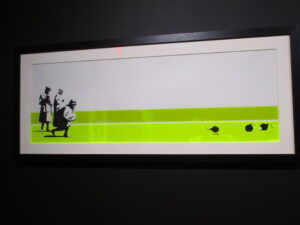
It shows people that it’s okay to not be a part of the problem but rather include them in the solution, through art they can stop for a moment and think about the rest for a minute.
Art shouldn’t be hard. Yes, you have your Dutch Master and your Renaissance, but if it wasn’t commissioned by a higher up in the Church, it should be made for the masses.
Tell me, what could be more gleaning a message to the future than learning from the past?
In one of his most stark images, Banksy takes the very stark image of a very famous photograph, Napalm Girl—an emaciated, naked girl from Vietnam in her Napalm burns, happily holding hands with both the king of American gluttony and the king of American happiness.
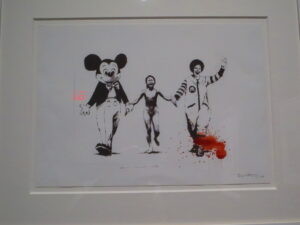
This one had two versions, but I chose to include the one with actual blood. Is it Damien Hirst’s blood or Banksy’s? Who cares? Blood is blood.
While Sales Ends Today went on the absurdity of his art gaining more ground, Banksy decided to drop a few more knowledge bombs on ya with Family Target, letting the audience know that in war, the smarter we get, the dumber we get, as it’s aiming for a kid on vacation.
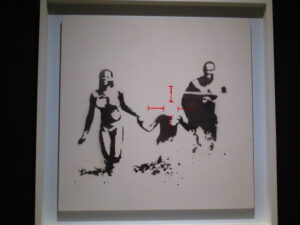
One of his most iconic pieces is Love Is In The Air (Flower Thrower) wherein he replaces a rock or a Molotov for a bouquet of flowers. I mean, if we could bomb each other with nothing but good vibes, the world would be a better place.
It would be more like 80s hip-hop, tagging, breakdancing—things that were all about community.
I digress.
Sometimes, things need to be aggressive to get the message across, especially when it comes down to outlaw art.
This was exemplified with the Peckham Trolley Postcard, in which he Rambo’d and illegally stuck a similar piece of cement to the British Museum to prove a point. Man hunts out of his grounds. They actually respected it.
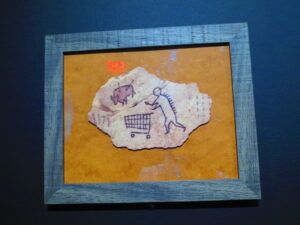
We cut to his Jack & Jill, Grannies, Turf War, Queen Vic, and Monkey Queen.
Out of all of these, the Turf War, a verbal and visual play on Winston Churchill’s speech held me the most.
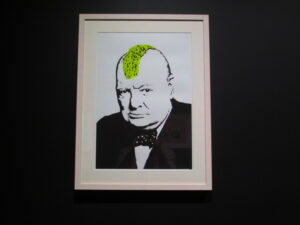
Now, the most arresting was Queen Vic, which was The Grandmother of Europe’s “facesitting” on another woman. It was the one that got Christina Aguilera buying and what shot Banksy into stardom. A place he never wanted to take up residence in. Art is for the People. He wanted to turn the museum inside out. Make it free and outside.
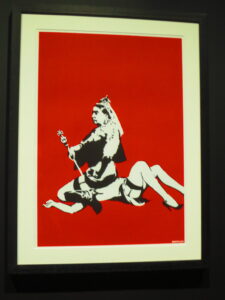
At some point, you could see beauty for free and if you were awarded the succinct moment, stop and think.
Now, his art was at the top of everybody’s list… but Banksy isn’t one to slouch. Though initially wanting to travel to Brazil, he settled on the Gaza Strip to create his most audacious works of art (to me) yet. He not only created and took a piece of the wall dividing Israel and Palestine, but he also took up a hotel and made it a living, breathing thinkpiece called the ‘Walled Off Hotel.’
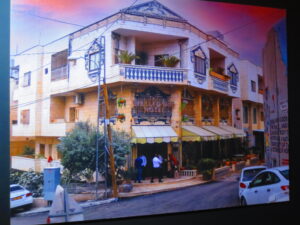
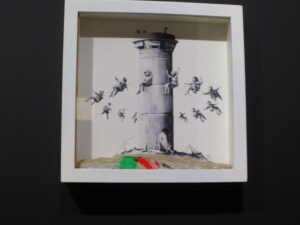
His whole joke was it was “the Hotel with the worst view in the world.”
To be fair, if you can’t ferry down the river of sadness with a motor of levity, then what have you?
Later on down the line, I get why he has such a love for pop art, aping some Warhol for a can (or four) of Tesco’s Tomato Soup for the interest of others. He doubled down with a key scene in Pulp Fiction, replacing the guns with bananas.
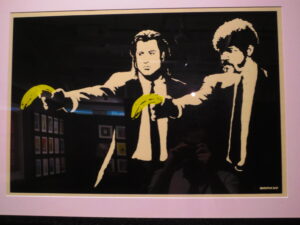
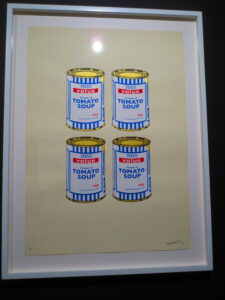
That is what we call a Mobius strip.
Next, we have something that Bansky has an affinity for debunking—Disney. His Mickey Snake was presented at Dismaland (Bemusement Park), where the attendants to the experience were to be miserable and serve the prickly provocateur. Hitting the nail on the head if turning a ball peened head is turning a blind eye to the ills of the world.
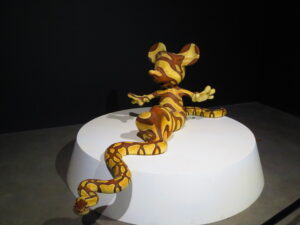
The fiberglass, resin, and acrylic piece were going for the throat, so to speak.
It’s easy to pull nice comfortable wool over our eyes, but just like the snake, that lump will still stay in our throats until we digest it… if we ever do.
Snakes take a long time to digest.
Moving onto one of my favorite pieces, there by the Grace of God goes with a double wall section that was painted over in red. The beautiful thing is that, even with his quote of “Every picture tells a lie,” this was done on purpose. Little did they know, hyperspectral photography is actually worth more than the walls themselves.
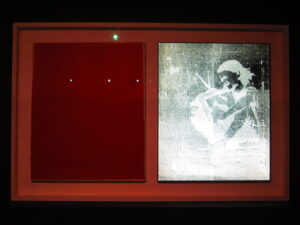
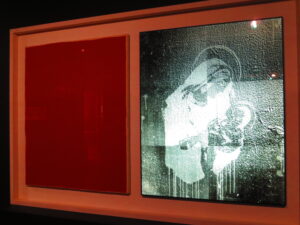
Where we wind down is the myriad albums Banksy had lent his art to.
Like any amazing artist, other arts creep in and music was easily in there.
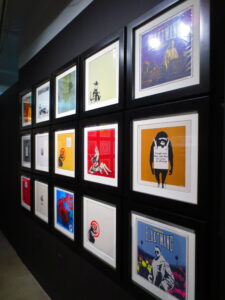
From 80s b-boy and hip-hop to Massive Attack and trip-hop, music can move you, and the artist willfully gave art to what is loved and the wellspring from whence inspiration came.
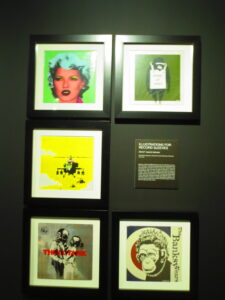
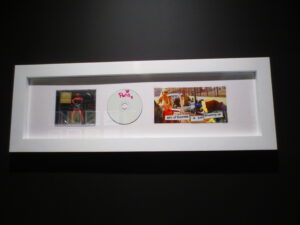
From turning Kate Moss into Marilyn Monroe to buying 500 of Paris Hilton’s albums and changing them into a national joke, the guy already had his eyes on toppling the nouveau riche while they crave what we already had when we were broke… Heart. Soul. Creation.
Rounding out on HMV, we’re musically going down to what it all boils down to. Bringing down a master’s voice.
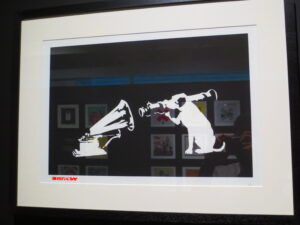
We kind of end up where most of us started – Girl With Balloon.
Whether you’ve come across it on Instagram, Facebook, or any semblance of social media, we invariably end on where it all started for the artist’s pick-up point.
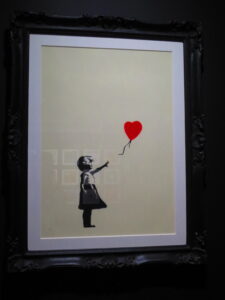
Banky’s shredding in Sotheby’s was simply a statement because, for those that want to spend crazy amounts on a statement, it’s easier and cheaper to buy a work of art than to make it.
Yes, it doubled in price once it was shredded, causing one work of art (Girl With Balloon) to develop into another (Love Is In The Bin) in real-time.
Maybe that’s the goal in a weird way.
No matter how deep your pockets are, it costs very little to be rich—a simple smile and a dap will do ya.
It costs little to nil to reach your fellow foe and make a new friend—just a simple stepping out of your comfort zone and seeing things from a new perspective. Some will see that as a King’s Ransom, but it isn’t that hard.
While the privileged few can spend a crazy amount of money to hang that same message on the walls of their palatial estate, Banksy took the idea of a museum and made it vomit so we can all enjoy it for free and feel like millionaires for a moment.
It just took but a single ingredient…perspective.
That is a luxury no amount of money can buy.
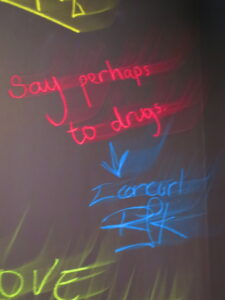
-Robert J. Kijowski
P.S. I want to take a minute to thank the amazing Elena Frigenti for such a special experience.
This was a legit blast, thanks to Pest Control ltd. and the curators Stefano Antonelli and Gianluca Marziani.
If you’re in the area and want to give this very well-thought-out exhibition a peek, it runs through September 5th and is located at 250 Bowery in New York.
Eileen Ramos’ Impressions
In traversing the new exhibit Banksy: Building Castles in the Sky, one thing became apparent—the artist is an idealist. Curated by Stefano Antonelli and Gianluca Marziani, there are over one hundred works authenticated by Pest Control Office ltd, the “Parent/Guardian of the artist Banksy”. Situated in New York City, at 250 Bowery Street, the former site of the International Center of Photography Museum, the exhibition makes great use of the space. Well-constructed and incredibly thought out, we gain a better idea of who Banksy is and what he is devoted to. Elena Frigenti was gracious to give a tour for Rob and me and she illuminated how Banksy is for the masses and far beyond just a simply cynical artist.
I highly recommend reading the curatorial statement at the start of the exhibit—“What are we looking at when we look at Banksy?” It’s honestly the best declaration I’ve read for any exhibition and provides a good foundation of how to view his works. Succinctly addressing the strange sensations we feel when we look at his art and the even stranger world we currently live in, the curators open the viewers’ eyes to the unreality that late stage Capitalism has granted us.
It also provides insight to the making of Banksy, pointing out the reign of the former United Kingdom Prime Minister and leader of the Conservative Party, Margaret Thatcher. Of which it therefore makes more sense how Banksy have become such an acerbic proponent against Capitalism. Before Building Castles, I just thought of the artist as a snarky genius. I had no clue how his art goes beyond sarcasm and is Anti-War, Anti-Indoctrination, and staunchly Anti-Capitalism.
Let’s take a look at one of his most famous artworks, “Love is in the Air (Flower Thrower)”
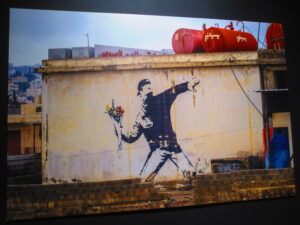
Displaying a young man in a backwards cap and the bottom of his face covered, he is preparing to launch a bouquet of flowers as if he’s throwing molotov cocktail. This first existed as a stencil in Jerusalem in 2003 and was painted on the wall to separate the Israelis and Palestinians in the West Bank. As noted in the plaque next to it “The artist sees the wall as something that ‘[…] essentially transforms Palestine into the largest open-air prison in the world.’” Normally seen on the red background and without the context of the wall, I didn’t know the backstory behind this piece. If it wasn’t for the exhibition, I’d continue to be ignorant of the historical context and the oppression being protested. This is way beyond a clever image but a commentary on the harsh and deeply cruel circumstances the youth must suffer through in order to survive. We expect destruction and violence in a stance—and place—like this and instead we are gifted beauty and peace, something we sadly don’t see in the Media we consume daily.
The further you go into the exhibit, the more connections you understand between Banksy’s and your (our) worlds. I have definitely hailed him as a brilliant artistic genius separate and above me. But it’s in witnessing his timeline and development that I share more common ground than I considered possible. This exhibit humanizes him and his art in a way that the (possibly mock) documentary “Exit Through the Gift Shop” does not. He still remains a shadowy figure whose appeal is largely his mysterious mystique. But there’s definitely an immense heart behind each and every one of his artworks.

That wasn’t his last work in Palestine, as he built in 2017, the Walled Off Hotel. As noted in the exhibition ,“It sounds like the famous Waldorf luxury hotel and consists in a small venue in Bethlehem, in front of which Israeli government built a wall to separate Israeli from Palestinian territories, contributing to the give the hotel ‘the worst view in the world’ a slogan with which the artist publicizes his initiative. The hotels contains works by Banksy and other artists, themed rooms, a souvenir shop where you can buy the poster and a shop where you can buy paint and tools to make your own street art.” Our tour guide, Elena, shared how this is the only place in the world where you can purchase his artwork, the money going to the people of Palestine. He hired professional bellhops and created fantastic galleries to showcase his and invited artists’ works. It’s an incredible endeavor to support the Oppressed and shine a light on their plight when many mainstream artists would turn their heads away.

What I also found riveting in Building Castles was how he uses the entire world as his studio and gallery. As noted on the plaque for the above piece, Peckham Trolley, Postcard—in 2005, Banksy masqueraded as a visitor to British Museum in order “to illegally install on a wall a piece of cement drawn with a felt-tip pen depicting a primitive man pushing a supermarket trolley. Just like other museum pieces, the artist places a caption:
“Wall art. East London. This finely preserved example of primitive art dates from the Post-Catatomic era and is thought to depict early man venturing towards the out-of-town hunting rounds. The artist responsible is known to have created a substantial body of work across South East of England i under the moniker Banksymus Maximus but little else is known about him. Most art of this type has unfortunately not survived. The majority is destroyed by zealous municipal officials who fail to recognize the artistic. Merit and historical value of daubing on walls.’”
This intervention lasted for 8 days when the Museum staff “notices the intruder, remove the piece, and store it in a museum’s warehouses. Banksy will comment ‘now it is housed in the permanent collection.’” There is way more to this story and in the plaque but I invite you to visit the work itself and see for yourself.
Such brilliance and noteworthy context in this and many plaques add more substance and thought for these artworks. I genuinely believe these captions add a level of vibrancy that I find absent in plaques found in other art galleries and museums. It’s a mark of a fantastic show if the reading of these texts can be just as riveting and captivating as the artworks themselves.
The exhibition shows other interventions Banksy has done, like the videos of his performances in public protests and the infamous shredding of his artwork once the Sotheby’s auction ended. It is inspiring to witness his rise and how he proliferated the world over with his art, influence, and uplifting endeavors. In fact, there are beautifully constructed data maps of his artwork and statements in time, and who influenced him in turn, such as Fluxus, Keith Haring, and Hip Hop. They even shared how they were able to build such a map, providing the name of the programs and algorithms used.
His artwork has always confronted you with reality, no matter how sardonic or surreal the imagery and icons used. The underlying message is to wake up the viewer and provoke reflection. To question the wars that are supposedly for the good of our nation. To doubt the need for borders at all. The mindless consumption of Disney and how it’s harshly impacting our youth. To combat why we must always destroy and consume when we can create and inspire instead.
There was a lovely parting gift at the end of the exhibit where attendees can contribute their own art on the wall chalkboard. I saw messages from visitors from around the world, like South Korea and Ireland, even Banksy’s rat climbing the Empire State Building. I’m sure many of the attendees felt just like me, thoroughly motivated to create art and spread it as wide as possible. Maybe planting a postcard at the MoMA or stenciling in a back alley.
After attending this well-researched and curated exhibition of one of my favorite artists ever, I wanted to seek out more street art and leave my own stamp in the world. I now see the world not as unstoppably hostile and cruel as I used to, but a canvas to inspire and move others as well as myself. As Banksy has shown us, art can awaken a deeper, more meaningful perspective and way of life. There are alternatives to the darkness of Capitalism and we can thrive in better, less horrific ways. Even if it means Building Castles in the Sky.
I am grateful to the curators, Stefano Antonelli and Gianluca Marziani, for the invitation to this wonderful exhibit. And to Elena Frigenti for such an enlightening tour. Definitely visit this exhibit if you can, it’s a truly captivating experience.
-Eileen Ramos
